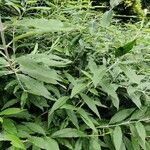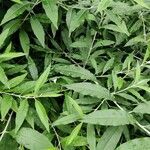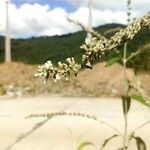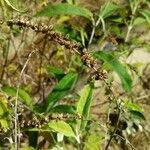Corolla white, sometimes pale violet or greenish, with erect lobes 1·3–3 times as long as the calyx and 3–6 mm. long, outside densely or less often sparsely stellate–tomentose; tube nearly cylindrical, 1·4–2·4 x as long as the calyx, 1·7–4 x as long as the lobes, 2·5–4·8 x 1·2–1·5 mm.; lobes orbicular or nearly so, 1–1·7 x 1–1·5 mm., rounded, entire or crenate, spreading.
An evergreen, tree like shrub. It grows 3 m high. New shoots are arching and woolly white. The leaves are long and narrow. They are dark green on the upper side and paler underneath. The flowers are in long drooping racemes. They are creamy white. They are fragrant. They flowers grow on last year's growth. The fruit is a capsule and is small and narrowly oval.
Leaves opposite, those in the inflorescence often more or less alternate, shortly petiolate; petiole 2–15 mm. long; blade narrowly to very narrowly elliptic or ovate, 3–8 times as long as wide, 3–30 x 0·5–7 cm., long–acuminate at the apex.
Pedicels very short, 0·2–2 mm. long; flowers fragrant, crowded or more or less remote, (sub)sessile, in 1–3–(rarely more) flowered cymes; each cyme in the axil of a linear bract.
Seeds pale brown, reticulate, winged at both ends, 0·8–1 x 0·3–0·4 x 0·2 mm.; grain ellipsoid, apiculate at both ends, 0·3–0·4 x 0·3 x 0·2 mm.
Calyx campanulate, 1·3–4·5 mm. long, outside stellate–pubescent or –tomentose; lobes 0·4–3 times as long as the tube, subequal.
Branchlets terete or nearly so, densely stellate–pubescent or –wooly with white, grey or fulvous hairs.
Capsule ellipsoid, 3–5 x 1·5–3 x 1·5–3 mm.; valves often tom at the apex.
Inflorescence terminal and/or axillary, thyrsoid, spiciform.
Shrub, undershrub or sometimes small tree, 0·80–7 m. high.
Ovary glabrous or lepidote.
Stamens included.





